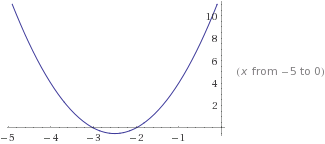This chapter contains
- Rational Functions
- Vertical Asymptotes
- Horizontal Asymptotes
Rational Functions
Much like a rational number, a rational function can be defined as any function in which both the numerator and denominator are polynomials. This can be written as the following equation:
The domain of the function is all real number, excluding any inputs that would result in D(x) equaling 0; this would create a vertical asymptote.
Vertical Asymptote
A vertical asymptote is formed when the denominator function, or D(x), is equal to zero. When this occurs, the output, or f(x), becomes undefined. When you graph this, you will notice that the graph will run along the vertical asymptote, up to infinity and negative infinity.
In order to find a vertical asymptote, you have to set D(x) equal to zero, solve out, and at the zeroes set vertical asymptotes in the graph.
Example:
Horizontal Asymptotes
A horizontal asymptote is a y coordinate in which the function cannot cross. The graph will get infinitesimally get closer to the asymptote in both the negative and positive infinity, but it will never reach it. A horizontal asymptote can be crossed at certain points (see figure below), but in the infinite and negative infinite directions it will not.
How to find the horizontal asymptote:
If the degree of the numerator is less than the denominator:
In this case, the horizontal asymptote will always be zero, but it is still possible for the graph to cross through zero. In the above example, the horizontal asymptote is 0, because the degree of the numerator is lower than the degree of the denominator.
If the numerator and denominator have equal degrees:
In this case, the horizontal asymptote is determined as follows:
if (only including the highest degrees)
then the asymptote will be at
If the degree of the numerator is greater than the degree of the denominator:
There is no horizontal asymptote.










.gif)

.gif)
.gif)
.gif)
.gif)

.gif)
.gif)
.gif)
.gif)
.gif)
.gif)